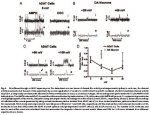Because this is a forum for advanced drug discussion, I thought it appropriate to start our own journal club. Though ADD doesn't get that much traffic, BL does, and it might attract the copyright police, so we should probably limit what is posted in ADDJC to open access articles such as the following. I only posted the figures because the full text is not yet available in any format other than pdf, which is available here:
http://www.pnas.org/cgi/reprint/0407737102v1
Without further ado:
Kristopher M. Kahlig, Francesca Binda, Habibeh Khoshbouei, Randy D. Blakely, Douglas G. McMahon, Jonathan A. Javitch, and Aurelio Galli. Amphetamine induces dopamine efflux through a dopamine transporter channel. PNAS published February 22, 2005, 10.1073/pnas.0407737102
http://www.pnas.org/cgi/reprint/0407737102v1
Without further ado:
Kristopher M. Kahlig, Francesca Binda, Habibeh Khoshbouei, Randy D. Blakely, Douglas G. McMahon, Jonathan A. Javitch, and Aurelio Galli. Amphetamine induces dopamine efflux through a dopamine transporter channel. PNAS published February 22, 2005, 10.1073/pnas.0407737102









